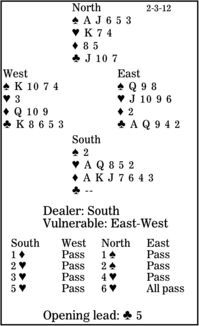Bridge column, February 3: The theme returns after a day's break

Diane Johnson, whose satirical novels often feature American heroines living abroad in contemporary France, said, "A novel's whole pattern is rarely apparent at the outset of writing."
A bridge contract's whole pattern had better be apparent at the outset of the playing, or the declarer is in trouble. In today's deal, how should South play in six hearts after ruffing West's club lead?
The bidding had a modern flavor. South's two-heart rebid was a reverse, showing both a strong hand (usually 17 to 20 points) and longer diamonds than hearts. (That isn't new. A reverse can be recognized in an uncontested auction because if the responder wishes to give preference to opener's first-bid suit, he must go to the three-level.) North's two-spade rebid promised only a five-card suit. Five hearts asked North to bid slam with good trumps. In context, North thought they were.
To make the contract, South must establish his diamonds, draw trumps, and run diamonds without losing more than one trick. It is tempting to try for an overtrick by drawing two rounds of trumps, then turning to diamonds. But that is fatal here. As mentioned two days ago, when declarer must establish his side suit, he should do that first.
The best line is to lead a heart to dummy's king (although that is not necessary), play a diamond to the ace, lead a spade to dummy's ace, and play a second diamond. East will discard, not "waste" his trump winner. So South wins with his king and ruffs a diamond in the dummy. East can get only one trump trick.
** ** **
COPYRIGHT 2012, UNITED FEATURE SYNDICATE
DISTRIBUTED BY UNIVERSAL UCLICK FOR UFS

